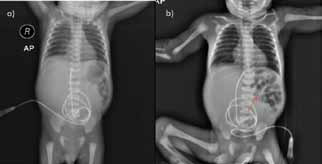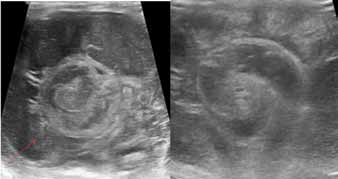Case Report
Ileal Volvulus without Malrotation in Newborn-Rare Presentation
Pathapati D1*, Nagendhar YM2, Siva Sahas N1, Bhavishya T1 and Jyothsna K1
1Department of Radiology, KIMS hospital enterprises pvt.ltd, Kondapur, Hyderabad, India.
2Department of paediatric surgery KIMS hospital enterprises pvt.ltd, Kondapur, Hyderabad, India
2Department of paediatric surgery KIMS hospital enterprises pvt.ltd, Kondapur, Hyderabad, India
*Corresponding author:Deepthi Pathapati, Department of Radiology, KIMS hospital enterprises pvt.ltd, Kondapur, Hyderabad, India. E-Mail Id :deepthipathapati82@gmail.com
Copyright: © 2024 Pathapati D, et al. This is an open access article distributed under the Creative Commons Attribution License, which permits unrestricted use, distribution, and reproduction in any medium, provided the original work is properly cited.
Article Information: Submission:16/07/2024; Accepted: 10/08/2024; Published: 12/08/2024
Abstract
Intestinal volvulus is a rare but life-threatening surgical emergency. Volvulus without malrotation is extremely rare, only few cases are reported till now in literature [1]. Prompt diagnosis and urgent surgical treatment is required if bowel necrosis is to be prevented, which is associated with increased mortality. We present a case of new born preterm baby (32 weeks) who presented with distension of abdomen immediately after birth which was gradually increasing. An USG abdomen revealed a “whirlpool sign” in the umbilical region, suggesting small bowel volvulus with intestinal obstruction. Laparotomy revealed a twisted, necrosed loop of small bowel in the umbilical region with abnormal adhesions between the distal ileum and caecum with mesenteric narrowing. Subsequent resection of the involved segment was done. Baby was discharged in stable condition on 7th post-operative day.
Keywords:Volvulus; Malrotation; Bowel Necrosis; Gangrenous.
Background
Majority of neonatal midgut volvulus cases are due to malrotation.
Some other causes can be due to postoperative adhesions, duplication
cyst, meconium “ileus”, and internal hernia. [2]Small bowel volvulus
refers to the abnormal twisting of a loop of small bowel about the axis of
its mesentery. This results in partial or complete mechanical intestinal
obstruction and eventually to bowel ischemia, necrosis, perforation
and peritonitis. [3] Segmental volvulus without malrotation is
extremely rare and has been reported only in few studies. Common
clinical presentation is bowel distension with features of intestinal
obstruction. Volvulus, in general, leads to necrosis of the involved
bowel segment. Prompt diagnosis and treatment are required to
prevent unnecessary resection and associated increased morbidity
and mortality.[4]
Case presentation
We report a case of preterm baby (32weeks), weighing 1400 g,
with APGAR score 7 and 8 at 1 and 5 min, respectively who presented
with distended abdomen and vague lump in right lumbar region after
birth. Investigational work-up was started including chest X-ray which
was normal, arterial blood gases showed mild metabolic acidosis. The
baby was referred to our radiological department for plain abdominal
X-ray in view of distended abdomen. The X-ray showed a distended
and gasless abdomen, except for a small amount of air in the stomach
[Figure 1a]. As the abdominal distension is increasing and due to
excessive cry of baby, radiograph was repeated after 4 hrs which
showed gas less abdomen in right lumbar, umbilical region and pelvis
with few airs filled bowel loops to left hypochondrium [Figure 1b].
In view of distension of abdomen and vague lump, USG abdomen
was done which showed aperistalitic dilated fluid filled bowel loops
with maximum diameter of 2cm in umbilical region with twisting
giving an appearance of ‘whirl pool’[Figure 2]. Upper GI study
using water soluble contrast was done which ruled out a malrotation
showing a normal gastric, duodenal, and normal location of the
Figure 1:a:Supine radiograph taken after 1 hour of birth showing air filled
bowel loops in left hypochondrium. b: radiograph taken after 4 hours of
birth showing air filled bowel loops in left hypochondrium with absent gas
shadows in rest of abdomen.
Figure 2:Dilated bowel loops with twisting noted in periumbilical region
giving an appearance of whirl pool sign. Maximum diameter of bowel loop
is 2cm.
Treitz ligament [Figure 3]. Based on imaging, provisional diagnosis
of intestinal (ileal) volvulus without malrotation was made. The baby
was operated on immediately after 10 hrs of birth in view of intestinal
obstruction. Intraoperative findings showed Ileal volvulus with
necrosed segment up to 30 cm extending up to IC Junction coursed by
adhesive band causing the twisting of loops. Proximal healthy small
bowel up to 50 cm was observed [Figure 4]. Resection of necrotic
ileum with santulli enterostomy was done. The postoperative period
was uneventful and baby was discharged on 7th post-operative day.
Discussion
Congenital volvulus is a life-threatening condition which
requires early and accurate diagnosis in order to identify the
appropriate treatment and reduce the risk of neonatal mortality.
Midgut volvulus usually occurs during the first year of life, with 60%
of cases occurring within the first month.[14] Neonatal volvulus
is usually secondary to malrotation and involves twisting of bowel
loop with its feeding vessels that leads to ischemia, necrosis, and
perforation with fatal complication, if not recognized and treated in
time. Intestinal volvulus without malrotation occurs in 19%-20% of
the small bowel volvulus in children.[5,6] The etiology of neonatal
volvulus without malrotation remains unknown. However, other rare
predisposing causes are Meckel’s diverticulum, duplication cyst, and
meconium plug. Delayed diagnosis can lead to significant morbidity
Figure 3:Ugi Study Serial radiographs are taken at 10min, 30min,1hr30min
and 2hrs 30min after giving oral contrast. Oesophagus, stomach and
duodenum are well opacified. The contrast is seen crossing DJ flexure with
opacification of proximal small bowel loops in left lumbar region. Rest of the
bowel loops are not opacified in delayed radiographs.
Figure 4:Intraoperative findings: Necrosed distal ileum noted close to IC
junction with twisting – s/o ILEAL VOLVULUS. Proximal small bowel loops
are normal.
and mortality.[5] In our case, band like mesentry was identified
which could be cause for ileal volvulus similar to case series reported
by Kitano et al., where there was long, narrow, band-like mesentery
seen in 3 cases, but the authors could not clarify whether this was the
result or the cause of the volvulus.[8]
The typical clinical picture of primary segmental volvulus is
acute intestinal strangulation manifesting early in life, and such
conditions have even been reported in fetuses. Compared to volvulus
with malrotation, the ischemic changes in the twisted bowel without
malrotation are thought to progress rapidly because the colon does
not act as a cushion.[9]
Diagnosis of volvulus in any suspected neonatal intestinal
obstruction by plain film and barium study is extremely difficult
especially when malrotation is ruled out.[2]
The sensitivity, specificity and positive predictive value of the
clockwise whirlpool sign for midgut volvulus are 92%, 100% and
100%, respectively. It should be noted, however, that sonography
is operator dependent and this may result in a missed diagnosis
resulting in fatal outcomes. Timely diagnosis of small bowel volvulus
is necessary as bowel necrosis is associated with increased mortality.
Prompt diagnosis and surgical management is necessary to
prevent the eventual ischaemia and gangrene due to small bowel
volvulus. The mortality associated with small bowel volvulus has been
quoted as high as 42–67% [5]
Conclusion
Based on our case, we suggest that in a case of suspected intestinal
obstruction, first we have to rule out intestinal malrotation with an
upper gastrointestinal barium study. Once malrotation is ruled out,
immediately we need to perform an ultrasound examination of the
abdomen to rule out an ileal volvulus as late diagnosis in volvulus
could be fatal. Thus, ultrasound examination that shows a target lesion
“bird beak” sign of the involved bowel allows to quickly identify this
morbid entity without loss of precious time.




